
Henry Walter Bates was an English naturalist and explorer who gave the first scientific account of mimicry in animals. He was most famous for his expedition to the rainforests of the Amazon with Alfred Russel Wallace, starting in 1848. Wallace returned in 1852, but lost his collection on the return voyage when his ship caught fire. When Bates arrived home in 1859 after a full eleven years, he had sent back over 14,712 species of which 8,000 were new to science. Bates wrote up his findings in his best-known work, The Naturalist on the River Amazons.
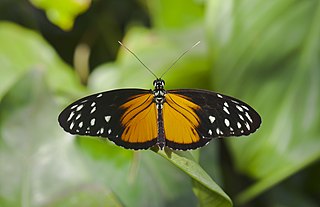
Heliconius hecale, the tiger longwing, Hecale longwing, golden longwing or golden heliconian, is a heliconiid butterfly that occurs from Mexico to the Peruvian Amazon. Hecale, was an old woman who gave shelter to Theseus on his way to capture the Marathonian Bull.
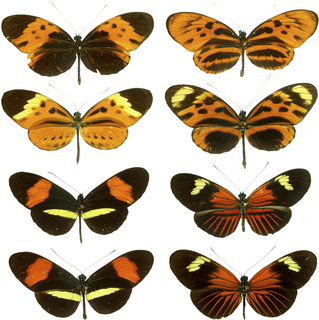
Heliconius comprises a colorful and widespread genus of brush-footed butterflies commonly known as the longwings or heliconians. This genus is distributed throughout the tropical and subtropical regions of the New World, from South America as far north as the southern United States. The larvae of these butterflies eat passion flower vines (Passifloraceae). Adults exhibit bright wing color patterns which signal their distastefulness to potential predators.
The variegated butterfly bat is a species of vesper bat. It is sometimes also called the leaf-winged bat, or simply the butterfly bat. It is not currently endangered, but may be threatened by habitat loss in some parts of its range.

Grafton is a village in Worcestershire, England.
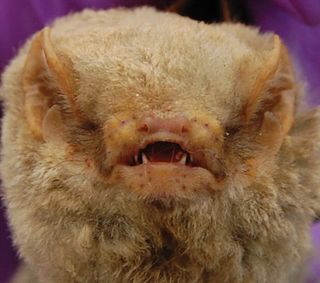
Glauconycteris is a genus of vespertilionid bats in Africa.

Ithomiini is a butterfly tribe in the nymphalid subfamily Danainae. Some authors consider the group to be a subfamily (Ithomiinae). These butterflies are exclusively Neotropical, found in humid forests from sea level to 3000 m, from Mexico to Argentina. There are around 370 species in some 40–45 genera.

Eunica is a genus of nymphalid butterflies found in the Neotropical realm.

Diaethria clymena, the Cramer's eighty-eight, is a species of butterfly of the family Nymphalidae. It is found from Mexico to Peru and Brazil. It was discovered to science by Pieter Cramer, in a fascicle of De uitlandsche Kapellen, 1775.

Hypoleria is a genus of clearwing (ithomiine) butterflies, named by Frederick DuCane Godman and Osbert Salvin in 1879. They are in the brush-footed butterfly family, Nymphalidae.

Hypothyris is a genus of clearwing (ithomiine) butterflies, named by Jacob Hübner in 1821. They are in the brush-footed butterfly family, Nymphalidae.
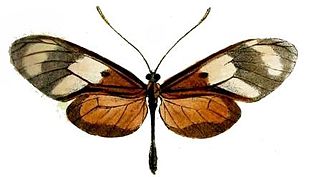
Callithomia lenea is a species of butterfly of the family Nymphalidae. It is found in Central and South America.

Forbestra is a genus of clearwing (ithomiine) butterflies, named by Fox in 1967. They are in the brush-footed butterfly family, Nymphalidae.
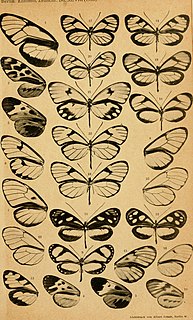
Napeogenes is a genus of clearwing (ithomiine) butterflies, named by Henry Walter Bates in 1862. They are in the brush-footed butterfly family, Nymphalidae.
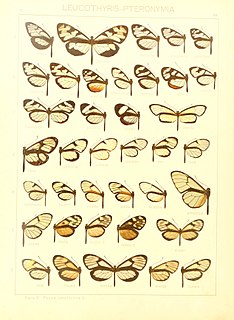
Pteronymia is a genus of clearwing (ithomiine) butterflies, named by Arthur Gardiner Butler and Herbert Druce in 1872. They are in the brush-footed butterfly family, Nymphalidae.

Thyridia is a monotypic genus of clearwing (ithomiine) butterflies, named by Jacob Hübner in 1816. Its only species is Thyridia psidii, the Melantho tigerwing or clapping ticlear. It is in the brush-footed butterfly family, Nymphalidae and is found in the Neotropical zone.

Antirrhea philoctetes, the common brown morpho or northern antirrhea, is a butterfly of the family Nymphalidae. It was described by Carl Linnaeus in 1758. It is found in Costa Rica, Panama, Guatemala, Colombia, Venezuela, the Guianas, Peru, Brazil and Bolivia.

Brachyglenis is a genus in the butterfly family Riodinidae present only in the Neotropical ecozone.















